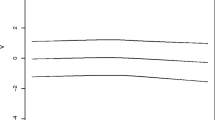Abstract
A method is proposed for empirically testing the appropriateness of using tetrachoric correlations for a set of dichotomous variables. Trivariate marginal information is used to get a set of one-degree of freedom chi-square tests of the underlying normality. It is argued that such tests should preferrably preceed further modeling of tetrachorics, for example, modeling by factor analysis. The assumptions are tested in some real and simulated data.
Similar content being viewed by others
References
Bock, R. D., & Aitkin, M. (1981). Marginal maximum likelihood estimation of item parameters: Application of an EM algorithm.Psychometrika, 46, 443–459.
Bock, R. D., & Lieberman, M. (1970). Fitting a response model forn dichotomously scored items.Psychometrika, 35, 179–197.
Brown, M. B., & Benedetti, J. K. (1977). On the mean and variance of the tetrachoric correlation coefficient.Psychometrika, 42, 347–355.
Christoffersson, A. (1975). Factor analysis of dichotomized variables.Psychometrika, 40, 5–32.
Divgi, D. R. (1979). Calculation of the tetrachoric correlation coefficient.Psychometrika, 44, 169–172.
Kendall, M., & Stuart, A. (1979).The advanced theory of statistics (Vol. 2). New York: McMillan.
Kirk, D. B. (1973). On the numerical approximation of the bivariate normal (tetrachoric) correlation coefficient.Psychometrika, 38, 259–268.
Muthén, B. (1978). Contributions to factor analysis of dichotomous dependent variables.Psychometrika, 43, 551–560.
Muthén, B. (1984). A general structural equation model with dichotomous, ordered categorical, and continuous latent variable indicators.Psychometrika, 49, 115–132.
Muthén, B. (1987).LISCOMP. Analysis of linear structural equations with a comprehensive measurement model. User's guide. Mooresville, IN: Scientific Software.
Muthén, B., & Christoffersson, A. (1981) Simultaneous factor analysis of dichotomous variables in several groups.Psychometrika, 46, 407–419.
Pearson, K., & Heron, D. (1913). On theories of association.Biometrika, 9, 159–315.
Vaswani, S. (1950). Assumptions underlying the use of the tetrachoric correlation coefficient.Sankhya, 10, 269–276.
Yule, G. U. (1912). On the methods of measuring association between two attributes.Journal of the Royal Statistical Society, 75, 579–652.
Author information
Authors and Affiliations
Rights and permissions
About this article
Cite this article
Muthén, B., Hofacker, C. Testing the assumptions underlying tetrachoric correlations. Psychometrika 53, 563–577 (1988). https://doi.org/10.1007/BF02294408
Received:
Revised:
Issue Date:
DOI: https://doi.org/10.1007/BF02294408




